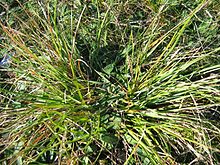Danthonia decumbens
| Danthonia decumbens | |
|---|---|
 | |
| Habitus | |
 | |
| Spikelets | |
| Scientific classification | |
| Kingdom: | Plantae |
| Clade: | Tracheophytes |
| Clade: | Angiosperms |
| Clade: | Monocots |
| Clade: | Commelinids |
| Order: | Poales |
| Family: | Poaceae |
| Genus: | Danthonia |
| Species: | D. decumbens |
| Binomial name | |
| Danthonia decumbens | |
| Synonyms [1] | |
| |
Danthonia decumbens (formerly Sieglingia decumbens) is a species of grass commonly known as the heath grass,[2] heath-grass,[3] or staggers grass[4] It is a tussock grass native to Europe and adjacent parts of Asia and North Africa. It may also be native to Newfoundland and Nova Scotia.
Description[edit]
Danthonia decumbens is a perennial plant with a decumbent habit; it lies on the ground with the tips turned upward.
It has narrow, bright green leaves taper to a sharp point and are rather hairy. A long upper leaf sheath clasps the delicate stem. The stem is 15–30 centimetres (5.9–11.8 in) high and slightly bent at the base, smooth with 1 to 3 nodes.
The ligule consists of a ring of hairs, as in the purple moor grass, Molinia caerulea, except that in this plant each end has a tuft of longer hairs.[2]
The panicle consists of 4 or 5 large erect glaucous silvery green or purplish awnless spikelets. These are arranged alternately on the upper part of the stem. The bunchgrass flowers in the summer months.
Ecology[edit]
The plant is found on acid pastures and heathland, on sandy or peat soils, which are also often damp.
The grass, having no domestic forage value, is not grown agriculturally.[2]
References[edit]
- ^ "Danthonia decumbens (L.) DC". The Plant List. Retrieved 27 April 2015.
- ^ a b c C. E. Hubbard (1978). Grasses. Revised by J. C. E. Hubbard (3rd ed.). Penguin Books. pp. 350–351. ISBN 978-0-14-013227-4.
- ^ Stace, Clive, 1997. New Flora of the British Isles. Second edition. p 899.
- ^ USDA, NRCS (n.d.). "Melica decumbens". The PLANTS Database (plants.usda.gov). Greensboro, North Carolina: National Plant Data Team. Retrieved 2 July 2015.
- Rose, Frances, 1974. Grasses, sedges and rushes, pages 20–21
External links[edit]
 Media related to Danthonia decumbens at Wikimedia Commons
Media related to Danthonia decumbens at Wikimedia Commons- Danthonia decumbens in GrassBase, Royal Botanic Gardens, Kew


 French
French Deutsch
Deutsch